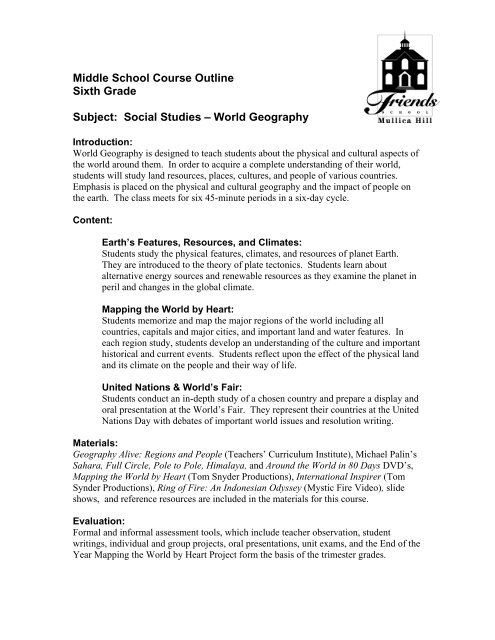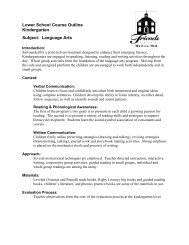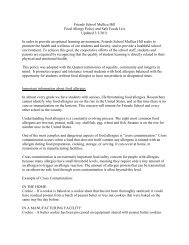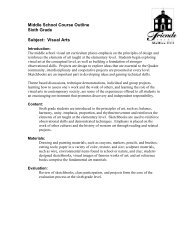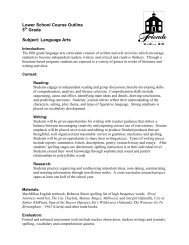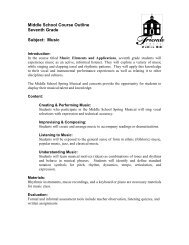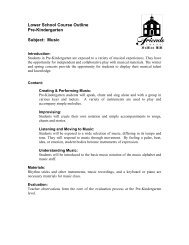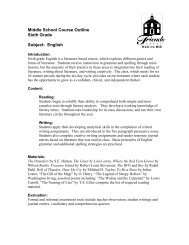Middle School Course Outline Sixth Grade Subject: Social Studies ...
Middle School Course Outline Sixth Grade Subject: Social Studies ...
Middle School Course Outline Sixth Grade Subject: Social Studies ...
You also want an ePaper? Increase the reach of your titles
YUMPU automatically turns print PDFs into web optimized ePapers that Google loves.
<strong>Middle</strong> <strong>School</strong> <strong>Course</strong> <strong>Outline</strong><br />
<strong>Sixth</strong> <strong>Grade</strong><br />
<strong>Subject</strong>: <strong>Social</strong> <strong>Studies</strong> – World Geography<br />
Introduction:<br />
World Geography is designed to teach students about the physical and cultural aspects of<br />
the world around them. In order to acquire a complete understanding of their world,<br />
students will study land resources, places, cultures, and people of various countries.<br />
Emphasis is placed on the physical and cultural geography and the impact of people on<br />
the earth. The class meets for six 45-minute periods in a six-day cycle.<br />
Content:<br />
Earth’s Features, Resources, and Climates:<br />
Students study the physical features, climates, and resources of planet Earth.<br />
They are introduced to the theory of plate tectonics. Students learn about<br />
alternative energy sources and renewable resources as they examine the planet in<br />
peril and changes in the global climate.<br />
Mapping the World by Heart:<br />
Students memorize and map the major regions of the world including all<br />
countries, capitals and major cities, and important land and water features. In<br />
each region study, students develop an understanding of the culture and important<br />
historical and current events. Students reflect upon the effect of the physical land<br />
and its climate on the people and their way of life.<br />
United Nations & World’s Fair:<br />
Students conduct an in-depth study of a chosen country and prepare a display and<br />
oral presentation at the World’s Fair. They represent their countries at the United<br />
Nations Day with debates of important world issues and resolution writing.<br />
Materials:<br />
Geography Alive: Regions and People (Teachers’ Curriculum Institute), Michael Palin’s<br />
Sahara, Full Circle, Pole to Pole, Himalaya, and Around the World in 80 Days DVD’s,<br />
Mapping the World by Heart (Tom Snyder Productions), International Inspirer (Tom<br />
Synder Productions), Ring of Fire: An Indonesian Odyssey (Mystic Fire Video), slide<br />
shows, and reference resources are included in the materials for this course.<br />
Evaluation:<br />
Formal and informal assessment tools, which include teacher observation, student<br />
writings, individual and group projects, oral presentations, unit exams, and the End of the<br />
Year Mapping the World by Heart Project form the basis of the trimester grades.
<strong>Middle</strong> <strong>School</strong> <strong>Course</strong> <strong>Outline</strong><br />
Seventh <strong>Grade</strong><br />
<strong>Subject</strong>: <strong>Social</strong> <strong>Studies</strong> – World History<br />
Introduction:<br />
Seventh <strong>Grade</strong> World History introduces students to a global picture of the people and<br />
events of world history. It is an in-depth survey of the history of human existence on<br />
earth with special emphasis on the mysteries of ancient civilizations. Students explore<br />
the relationship between the challenges faced by early civilizations and how they might<br />
relate to today’s civilizations. They meet for six 45-minute periods in a six-day cycle.<br />
Content:<br />
Early Humankind<br />
Students study the Paleolithic and Neolithic humans from archaeology and<br />
anthropology research. They discuss the theories of evolution and creationism.<br />
Ancient River Valley Civilizations:<br />
Students explore the civilizations of the Mesopotamia, the Egyptians in the Nile<br />
River Valley, the Indus River Valley, and the Huang Ho Valley.<br />
Pre-Columbian Civilizations:<br />
Students examine the civilizations of the Olmecs, Aztecs, Mayans, and Incas.<br />
Ancient Greeks:<br />
Students study the ancient Greeks and their impact on democracy. They also<br />
become familiar with their influence of trade and ideas.<br />
Five Great Religions:<br />
Students compare and contrast the five great religions: Judaism, Christianity,<br />
Islam, Buddhism, and Hinduism. They learn about Tibetan Buddhism and the<br />
history of Tibet. They examine the Tibetan culture and role of the Dalai Lama.<br />
Holocaust:<br />
Students learn about the genocide of the Jewish population by the Nazi regime.<br />
They examine other examples of genocide of yesterday and today.<br />
United Nations Day & World’s Fair:<br />
For the World’s Fair, students prepare a display and oral presentation for a chosen<br />
country. They represent their countries in the United Nations Day’s debates of<br />
issues and resolution writing.<br />
Materials:<br />
History Alive: The Ancient World (Teachers’ Curriculum Institute), Night by Elie Wiesel,<br />
UpFront Magazine (NY Times), Gods, Graves, and Scholars (C.W. Ceram), “In Search<br />
of Human Origins” (PBS/Donald Johanson), and “This Old Pyramid” are the materials.<br />
Evaluation:<br />
Formal and informal assessment tools, which include teacher observation, student<br />
writings, projects, and unit exams, form the basis of the trimester grades.
<strong>Middle</strong> <strong>School</strong> <strong>Course</strong> <strong>Outline</strong><br />
8 th <strong>Grade</strong><br />
<strong>Subject</strong>: Civics<br />
Introduction:<br />
Eighth grade civics introduces students to the historical development of the government<br />
of the United States and engages the students in a survey of important movements<br />
throughout the world that attempted to erase intolerance and injustice. Students will gain<br />
an appreciation and a responsibility for the role of being a contributing citizen. Through<br />
lecture, cooperative group work, discussions, readings, field trips, guest speakers, and<br />
writing students will be engaged in the study of civics. The eighth grade students are<br />
responsible for the leadership of the <strong>Middle</strong> <strong>School</strong> United Nations Day.<br />
Content:<br />
United States Constitution:<br />
The course is designed to study the history, purpose and function of the executive,<br />
legislative and judicial branches of government at the federal, state and local<br />
levels. Students will carefully study the United States Constitution and use this as<br />
a framework in their study of important movements throughout human history.<br />
Civil Rights:<br />
Students will engage in units covering the U.S. Civil Rights Movement,<br />
intolerance in America, non-violent resistance, and women’s history month.<br />
Current Events:<br />
Current, national and international affairs are discussed throughout the year.<br />
These affairs will be learned within the context of the United States foreign policy<br />
decisions to allow students to explore the role of the United States within the<br />
world community.<br />
Materials:<br />
The text, Overview of Important Facts and History of the Constitution and the Three<br />
Branches of Government, and a variety of websites, video, and audio materials comprise<br />
the materials list.<br />
Evaluation Process:<br />
Students receive trimester grades based on their performance on test, quizzes, group and<br />
individual projects, homework, class participation and written work.


